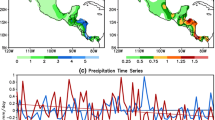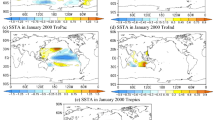Abstract
The potential role of tropical Pacific forcing in driving the seasonal variability of the Arctic Oscillation (AO) is explored using both observational data and a simple general circulation model (SGCM). A lead–lag regression technique is first applied to the monthly averaged sea surface temperature (SST) and the AO index. The AO maximum is found to be related to a negative SST anomaly over the tropical Pacific three months earlier. A singular value decomposition (SVD) analysis is then performed on the tropical Pacific SST and the sea level pressure (SLP) over the Northern Hemisphere. An AO-like atmospheric pattern and its associated SST appear as the second pair of SVD modes. Ensemble integrations are carried out with the SGCM to test the atmospheric response to different tropical Pacific forcings. The atmospheric response to the linear fit of the model’s empirical forcing associated with the SST variability in the second SVD modes strongly projects onto the AO. Idealized thermal forcings are then designed based on the regression of the seasonally averaged tropical Pacific precipitation against the AO index. Results indicate that forcing anomalies over the western tropical Pacific are more effective in generating an AO-like response while those over the eastern tropical Pacific tend to produce a Pacific-North American (PNA)-like response. The physical mechanisms responsible for the energy transport from the tropical Pacific to the extratropical North Atlantic are investigated using wave activity flux and vorticity forcing formalisms. The energy from the western tropical Pacific forcing tends to propagate zonally to the North Atlantic because of the jet stream waveguide effect while the transport of the energy from the eastern tropical Pacific forcing mostly concentrates over the PNA area. The linearized SGCM results show that nonlinear processes are involved in the generation of the forced AO-like pattern.










Similar content being viewed by others
References
Ambaum MHP, Hoskins BJ, Stephenson DB (2001) Arctic Oscillation or North Atlantic Oscillation? J Clim 14:3495–3507
Barnett TP (1985) Variations in near-global sea level pressure. J Atmos Sci 42:478–501
Barnston AG, Livezey RE (1987) Classification, seasonality and persistence of low-frequency atmospheric circulation patterns. Mon Weather Rev 115:1083–1126
Branstator G (2002) Circumglobal teleconnections, the jetstream waveguide, and the North Atlantic Oscillation. J Clim 15:1893–1910
Cash BA, Kushner PJ, Vallis GK (2002) The structure and composition of the annular modes in an aquaplanet general circulation model. J Atmos Sci 59:3399–3414
Cohen J, Entekhabi D (2001) The influence of snow cover on Northern Hemisphere climate variability. Atmos Oceanogr 39:35–53
Derome J, Brunet G, Plante A, Gagnon N, Boer G, Zwiers F, Lambert S, Sheng J, Ritchie H (2001) Seasonal predictions based on two dynamical models. Atmos Ocean 39:485–501
Derome J, Lin H, Brunet G (2005) Seasonal forecasting with a simple general circulation model: predictive skill in the AO and PNA. J Clim 18:597–609
Deser C (2000) On the teleconnectivity of the Arctic Oscillation. Geophys Res Lett 27(6):779–782
Dommenget D, Latif M (2002) A cautionary note on the interpretation of EOFs. J Clim 15:216–225
Greatbatch RJ, Lin H, Lu J, Peterson KA, Derome J (2003) Tropical/extratropical forcing of the AO/NAO: a corrigendum. Geophys Res Lett 30:1738. doi:10.1029/2003GL017406
Hall NMJ (2000) A simple GCM based on dry dynamics and constant forcing. J Atmos Sci 57:1557–1572
Hall NMJ, Derome J (2000) Transience, nonlinearity, and eddy feedback in the remote response to El Niño. J Atmos Sci 57:3992–4007
Hoerling MP, Hurrell JW, Xu T (2001) Tropical origins for recent North Atlantic climate change. Science 292:90–92
Hoerling MP, Hurrell JW, Xu T, Phillips A (2004) Twentieth century North Atlantic climate change. Part II: understanding the effect of Indian Ocean warming. Clim Dyn 23:391–405
Hurrell JW (1995) Decadal trends in the North Atlantic Oscillation: regional temperatures and precipitation. Science 269:676–679
Hurrell JW (1996) Influence of variations in extratropical wintertime teleconnections on Northern Hemisphere temperature. Geophys Res Lett 23(6):665–668
Jia XJ, Derome J, Lin H (2007) Comparison of the life cycles of the NAO using different definitions. J Clim 20:5992–6001
Kalnay E, Kanamitsu M, Kistler R, Collins W, Deaven D, Gandin L, Iredell M, Saha S, White G, Woolen J, Zhu Y, Chelliah M, Ebisuzaki W, Higgins W, Janowiak J, Mo KC, Ropelewski C, Wang J, Leetmaa A, Reynolds R, Jenne R, Joseph D (1996) The NCEP/NCAR 40-year reanalysis project. Bull Am Meteo Soc 77:437–471
Kumar A, Hoerling MP (2003) The natural and causes for the delayed response to El Niño. J Clim 16:1391–1403
Kushnir Y (1994) Interdecadal variations in North Atlantic sea surface temperature and associated atmospheric conditions. J Clim 7:141–157
Latif M, Grötzner A (2000) The equatorial Atlantic oscillation and its response to ENSO. Clim Dyn 16:213–218
Li S, Hoerling MP, Peng S, Weickmann KM (2006) The annular response to Tropical Pacific SST forcing. J Clim 19:1802–1819
Limpasuvan V, Hartmann DL (1999) Eddies and the annular modes of climate variability. Geophys Res Lett 26:3133–3136. doi:10.1029/1999GL010478
Limpasuvan V, Hartmann DL (2000) Wave-maintained annular modes of climate variability. J Clim 13:4414–4429
Lin H, Derome J (2004) Nonlinearity of the extratropical response to tropical forcing. J Clim 17:2597–2608
Lin H, Derome J, Brunet G (2005) Tropical Pacific link to the two dominant patterns of atmospheric variability. Geophys Res Lett 32:L03801. doi:10.1029/2004GL021495
Lin H, Brunet G, Derome J (2007) Intraseasonal variability in a dry atmospheric model. J Atmos Sci 64:2422–2441
Mehta VM, Suarez MJ, Manganello J, Delworth TL (2000) Ocean influence on the North Atlantic Oscillation and associated Northern Hemisphere climate variations: 1959–1993. Geophys Res Lett 27:121–124. doi:10.1029/1999GL002381
Peterson KA, Greatbatch RJ, Lu J, Lin H, Derome J (2002) Hindcasting the NAO using diabatic forcing of a simple AGCM. Geophys Res Lett 29:1336.doi:10.1029/2001GL014502
Pozo-Vazquez D, Esteban-Parra MJ, Rodrigo FS, Castro-Diez Y (2001) The association between ENSO and winter atmospheric circulation and temperature in the North Atlantic region. J Clim 14:3408–3420
Rajagopalan B, Kushnir Y, Tourre Y (1998) Observed decadal midlatitude and tropical Atlantic climate variability. Geophys Res Lett 25:3967–3970
Richman MB (1986) Rotation of principal components. J Climatol 6:293–335
Robertson AW, Mechoso CR, Kim YJ (2000) The influence of Atlantic sea surface temperature anomalies on the North Atlantic Oscillation. J Clim 13:122–138
Rodwell MJ, Rowell DP, Folland CK (1999) Oceanic forcing of the wintertime North Atlantic Oscillation and European climate. Nature 398:320–323
Saravanan R, Chang P (2000) Interaction between tropical Atlantic variability and El Nino-Southern Oscillation. J Clim 13:2177–2194
Sardeshmukh PD, Hoskins BJ (1988) The generation of global rotational flow by steady, idealized tropical divergence. J Atmos Sci 45:1228–1251
Sheng J, Derome J, Klasa M (1998) The role of transient disturbances in the dynamics of the Pacificborth American pattern. J Clim 11:523–536
Takaya K, Nakamura H (2001) A formulation of a phase-independent waveactivity flux for stationary and migratory quasigeostrophic eddies on a zonally varying basic flow. J Atmos Sci 58:608–627
Thompson DWJ, Wallace JM (1998) The Arctic Oscillation signature in wintertime geopotential height and temperature fields. Geophys Res Lett 25:1297–1300. doi:10.1029/98GL00950
Vallis GK, Gerber EP, Kushner PJ, Cash BA (2004) A mechanism and simple dynamical model of the North Atlantic Oscillation and annular modes. J Atmos Sci 61:264–280
van Loon H, Rogers JC (1978) The seesaw in winter temperatures between Greenland and northern Europe. Part I: general description. Mon Weather Rev 106:296–310
Walker GT (1924) Correlation of seasonal variations in weather IX: a further study of world weather. Mem Indian Meteor Dep 24:275–332
Wu AM, Hsieh WW (2004) The nonlinear association between ENSO and the Euro-Atlantic winter sea level pressure. Clim Dyn 23:859–868
Xie P, Arkin PA (1997) Global precipitation: a 17-year monthly analysis based on gauge observations, satellite estimates, and numerical model outputs. Bull Am Meteor Soc 78:2539–2558
Xie P, Rudolf B, Schneider U, Arkin PA (1996) Gauge-based monthly analysis of global land precipitation from 1971–1994. J Geophys Res 101(D14):19023–19034
Zhou S, Miller AJ (2005) The interaction of the MaddenJulian Oscillation and the Arctic Oscillation. J Clim 18:143–159
Acknowledgments
This research was funded by the Natural Sciences and Engineering Research Council of Canada and the Canadian Foundation for Climate and Atmospheric Sciences through the Canadian Climate Variability Research Network. We are grateful to Lisa LeBlanc for her many useful comments. We are also grateful to the two anonymous reviewers for their helpful suggestions on improving our paper.
Author information
Authors and Affiliations
Corresponding author
Rights and permissions
About this article
Cite this article
Jia, X., Lin, H. & Derome, J. The influence of tropical Pacific forcing on the Arctic Oscillation. Clim Dyn 32, 495–509 (2009). https://doi.org/10.1007/s00382-008-0401-y
Received:
Accepted:
Published:
Issue Date:
DOI: https://doi.org/10.1007/s00382-008-0401-y




